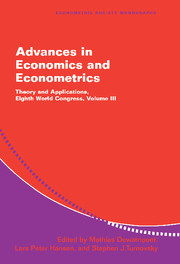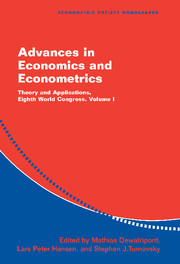20 results
Frontmatter
-
- Book:
- Advances in Economics and Econometrics
- Published online:
- 23 December 2009
- Print publication:
- 20 January 2003, pp i-vi
-
- Chapter
- Export citation
List of Contributors
-
- Book:
- Advances in Economics and Econometrics
- Published online:
- 23 December 2009
- Print publication:
- 20 January 2003, pp ix-x
-
- Chapter
- Export citation
Index
-
- Book:
- Advances in Economics and Econometrics
- Published online:
- 23 December 2009
- Print publication:
- 20 January 2003, pp 365-371
-
- Chapter
- Export citation
Frontmatter
-
- Book:
- Advances in Economics and Econometrics
- Published online:
- 19 January 2010
- Print publication:
- 20 January 2003, pp i-vi
-
- Chapter
- Export citation
Contents
-
- Book:
- Advances in Economics and Econometrics
- Published online:
- 19 January 2010
- Print publication:
- 20 January 2003, pp vii-viii
-
- Chapter
- Export citation
Contents
-
- Book:
- Advances in Economics and Econometrics
- Published online:
- 23 December 2009
- Print publication:
- 20 January 2003, pp vii-viii
-
- Chapter
- Export citation
Index
-
- Book:
- Advances in Economics and Econometrics
- Published online:
- 06 January 2010
- Print publication:
- 20 January 2003, pp 291-296
-
- Chapter
- Export citation
Preface
-
- Book:
- Advances in Economics and Econometrics
- Published online:
- 23 December 2009
- Print publication:
- 20 January 2003, pp xi-xii
-
- Chapter
- Export citation
Index
-
- Book:
- Advances in Economics and Econometrics
- Published online:
- 19 January 2010
- Print publication:
- 20 January 2003, pp 371-380
-
- Chapter
- Export citation
List of Contributors
-
- Book:
- Advances in Economics and Econometrics
- Published online:
- 19 January 2010
- Print publication:
- 20 January 2003, pp ix-x
-
- Chapter
- Export citation
Preface
-
- Book:
- Advances in Economics and Econometrics
- Published online:
- 06 January 2010
- Print publication:
- 20 January 2003, pp xi-xii
-
- Chapter
- Export citation

Advances in Economics and Econometrics
- Theory and Applications, Eighth World Congress
-
- Published online:
- 06 January 2010
- Print publication:
- 20 January 2003
Contents
-
- Book:
- Advances in Economics and Econometrics
- Published online:
- 06 January 2010
- Print publication:
- 20 January 2003, pp vii-viii
-
- Chapter
- Export citation
Preface
-
- Book:
- Advances in Economics and Econometrics
- Published online:
- 19 January 2010
- Print publication:
- 20 January 2003, pp xi-xii
-
- Chapter
- Export citation

Advances in Economics and Econometrics
- Theory and Applications, Eighth World Congress
-
- Published online:
- 23 December 2009
- Print publication:
- 20 January 2003
List of Contributors
-
- Book:
- Advances in Economics and Econometrics
- Published online:
- 06 January 2010
- Print publication:
- 20 January 2003, pp ix-x
-
- Chapter
- Export citation
Frontmatter
-
- Book:
- Advances in Economics and Econometrics
- Published online:
- 06 January 2010
- Print publication:
- 20 January 2003, pp i-vi
-
- Chapter
- Export citation

Advances in Economics and Econometrics
- Theory and Applications, Eighth World Congress
-
- Published online:
- 19 January 2010
- Print publication:
- 20 January 2003
7 - Transition as a process of large-scale institutional change
-
-
- Book:
- Advances in Economics and Econometrics: Theory and Applications
- Published online:
- 05 January 2013
- Print publication:
- 20 February 1997, pp 240-278
-
- Chapter
- Export citation
2 - Efficient governance structure: implications for banking regulation
-
-
- Book:
- Capital Markets and Financial Intermediation
- Published online:
- 04 August 2010
- Print publication:
- 20 May 1993, pp 12-35
-
- Chapter
- Export citation



